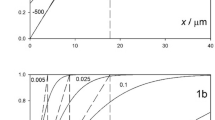Abstract
This work aims at considering the theoretical basis of chemical diffusion of electroactive species in ionic compounds, in particular from the perspective of the chemical equilibrium constraint. For this purpose, first a variety of descriptions on diffusivity are briefly summarised from the viewpoint of driving forces. Then, the equations to stand for the chemical diffusion behaviour are theoretically derived with and without the chemical equilibrium constraint. Finally, the two different situations above are critically compared to explore the origin of chemical diffusion in ionic compounds.


Similar content being viewed by others
References
Weppner W (1995) Electrode performance. In: Bruce PG (ed) Solid state electrochemistry. Cambridge University Press, New Work, pp 199–228
Pyun SI (1999) J Corros Sci Korea 28:1
Wagner C (1930) Z Phys Chem B 11:139
Wagner C (1936) Z Phys Chem B 32:447
Mott NF, Gurney RW (1940) Electronic processes in ionic crystals. Clarendon, Oxford, p 256
Bardeen J, Brattain WH, Shockley W (1946) J Chem Phys 14:714 doi:10.1063/1.1724091
Harned S (1947) Chem Rev 40:461 doi:10.1021/cr60127a004
Jaffe G (1952) Phys Rev 85:354 doi:10.1103/PhysRev.85.354
Eigen M, De Mayer L (1956) Z Elektrochem 60:1037
Reiss H, Fuller CS, Morin FJ (1956) Bell Syst Tech J 35:535
Oel HJ (1957) Z Phys Chem 10:165
Tomas DG (1957) J Phys Chem Solids 3:229 doi:10.1016/0022-3697(57)90027-6
Kurtz AD, Gravel CL (1958) J Appl Phys 29:1456 doi:10.1063/1.1722968
Rice SA (1958) Phys Rev 112:804 doi:10.1103/PhysRev.112.804
Kurtz AD, Yu R (1960) J Appl Phys 31:303 doi:10.1063/1.1735562
Mizuno H, Miyamoto S (1961) Physica 27:800 doi:10.1016/0031-8914(61)90100-8
Shewmon PG (1963) Diffusion in solid. McGraw-Hill, New York, pp 1–39
Kroeger FA (1964) The chemistry of imperfect crystals. North-Holland, Amsterdam, pp 794–813
Prigogine I (1967) Thermodynamics of irreversible processes. Interscience, New York, pp 55–74
De Groot SR, Mazur P (1969) Non-equilibrium thermodynamics. North-Holland, Amsterdam, pp 239–246
Sockel HG, Schmalzried H, Wynnyckyj JR (1969) Z Phys Chem 68:49
Wagner C (1969) Acta Metall 17:99 doi:10.1016/0001-6160(69)90131-X
Wagner C (1972) Prog Solid State Chem 7:1 doi:10.1016/0079-6786(72)90003-9
Schmalzried H (1981) Solid state reaction. Verlag Chemie, Weinheim, pp 59–91
Brett CMA, Brett AMO (1993) Electrochemistry principles, methods, and applications. Oxford University Press, New York, pp 25–31
Bockris JOM, Reddy AKN, Gamboa-Aldeco M (2000) Modern electrochemistry, second edn. Kluwer Academic, New York, p 448
Bard AJ, Faulkner LR (2001) Electrochemical methods: fundamentals and applications, 2nd ed. John Wiley and Sons, New York, pp 28–43
Chiang YM, Birnie DP, Kingery WD (1997) Physical ceramics: principles for ceramic science and engineering. Wiley, New York, pp 185–262
Herring C (1950) J Appl Phys 21:437 doi:10.1063/1.1699681
Ruoff AL (1965) J Appl Phys 36:2903 doi:10.1063/1.1714604
Fischmeister H, Grimvall G (1973) Ostwald ripening—a survey. In: Kuzynski GC (ed) Sintering and related phenomena. Plenum, New Work, pp 119–150
Rahaman MN (1995) Ceramic processing and sintering. Marcel Dekker, New York,, pp 367–373
Kopidakis N, Schiff EA, Park NG, van de Lagemaat J, Frank AJ (2000) J Phys Chem B 104:3930 doi:10.1021/jp9936603
Nakade S, Kambe S, Kitamura T, Wada Y, Yanagida S (2001) J Phys Chem B 105:9150 doi:10.1021/jp011375p
Kang SJL (2005) Sintering: densification, grain growth and microstructure. Elsevier, Amsterdam, pp 181–196
Schmalzried H (1995) Chemical kinetics of solids. VCH, Weinheim, pp 95–136
Readey DW (1966) J Appl Phys 37:2309 doi:10.1063/1.1708809
Gordon RS (1973) J Am Ceram Soc 56:147 doi:10.1111/j.1151-2916.1973.tb15431.x
Maier J (1993) J Am Ceram Soc 76:1223 doi:10.1111/j.1151-2916.1993.tb03745.x
Maier J (1993) J Am Ceram Soc 76:1228 doi:10.1111/j.1151-2916.1993.tb03746.x
Kreuer KD (1999) Solid State Ionics 125:285 doi:10.1016/S0167-2738(99)00188-5
Kang SJL, Yoo HI (2004) J Am Ceram Soc 87:2286 doi:10.1111/j.1151-2916.2004.tb07506.x
Goors WG (2007) Solid State Ionics 178:481 doi:10.1016/j.ssi.2006.11.004
Bae JS, Pyun SI (1996) Solid State Ionics 90:251 doi:10.1016/S0167-2738(96)00378-5
Lee JW, Pyun SI (2003) J Power Sources 119–121:760 doi:10.1016/S0378-7753(03)00217-9
Pyun SI, Choi YM, Jeng ID (1997) J Power Sources 68:593 doi:10.1016/S0378-7753(96)02635-3
Kim SW, Pyun SI (2002) J Electroanal Chem 528:114 doi:10.1016/S0022-0728(02)00900-2
Choi YM, Pyun SI (1997) Solid State Ionics 99:173 doi:10.1016/S0167-2738(97)00253-1
Choi YM, Pyun SI, Bae JS, Moon SM (1995) J Power Sources 56:25 doi:10.1016/0378-7753(95)80004-Z
Acknowledgements
This work supported by a grant-in-aid for the National Core Research Center Program from MOST and KOSEF (No. R15-2006-022-01001-0). Furthermore, this work was partly supported by the Brain Korea 21 project.
Author information
Authors and Affiliations
Corresponding author
Rights and permissions
About this article
Cite this article
Lee, SJ., Pyun, SI. & Shin, HC. Chemical diffusion of electroactive species in ionic compounds: a focus on chemical equilibrium constraint. J Solid State Electrochem 13, 829–836 (2009). https://doi.org/10.1007/s10008-008-0617-0
Received:
Accepted:
Published:
Issue Date:
DOI: https://doi.org/10.1007/s10008-008-0617-0




